Instructions for Side by Side Printing
- Print the notecards
- Fold each page in half along the solid vertical line
- Cut out the notecards by cutting along each horizontal dotted line
- Optional: Glue, tape or staple the ends of each notecard together
Structure and Function of Plants (Lab Practical #1)
front 1 What do all cells possess? | back 1 A cell wall and protoplast. |
front 2 What is the main purpose of the cell wall? | back 2 It surrounds the plant cell and holds the contents of the cell together. |
front 3 What other functions does the cell wall serve? | back 3 Facilitates communication and the transfer of substances between cells. |
front 4 What makes up the cell wall of plants? | back 4 - Middle Lamella
|
front 5 What does the middle lamella do? | back 5 Cements the primary walls of adjacent cells together. |
front 6 What is the primary wall? | back 6 The outermost layer of the cell wall. |
front 7 What is the secondary wall? | back 7 The innermost layer of the cell wall. |
front 8 What is the plasmodesmata? | back 8 Cytoplasmic threads that extend through openings in cell walls and connect the protoplasts of adjacent living cells (for communication). |
front 9 What is the protoplast? | back 9 All of the contents within the plant cell (includes nucleus and cytoplasm). |
front 10 What is within the plant cell's cytoplasm? | back 10 - Nucleus
|
front 11 What is a plastid? | back 11 An organelle within the cell that is in charge of food manufacture and storage. |
front 12 What are some examples of plastids? | back 12 Chloroplast
|
front 13 What is the vacuole? | back 13 A space within the cytoplasm filled with watery fluid. |
front 14 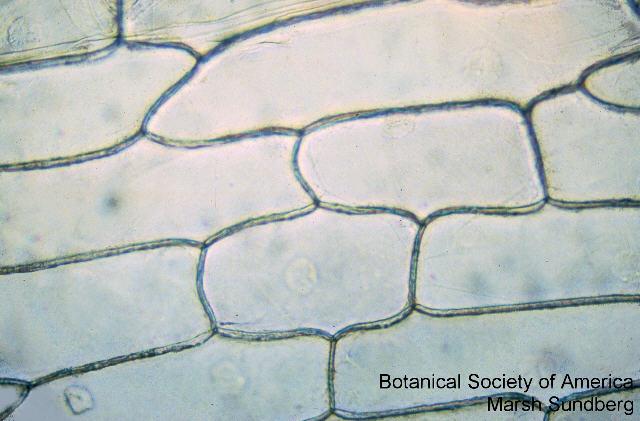 What are these cells from? Locate the cell wall, nucleus, and cytoplasm. | back 14 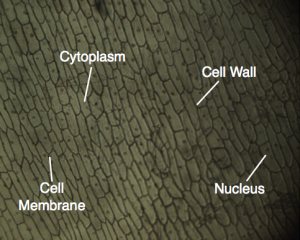 The epidermis of an onion. |
front 15 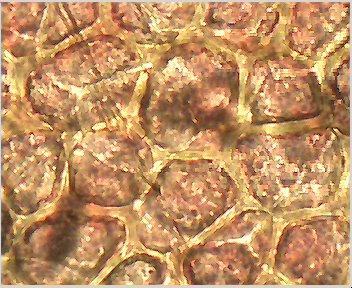 What lab specimen are these cells from? Locate the cell wall, cell lumen, middle lamella and plasmodesmata. | back 15 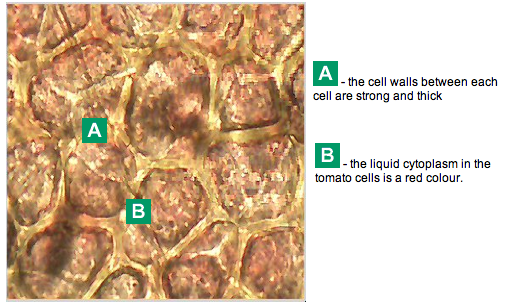 The epidermis of a tomato. |
front 16 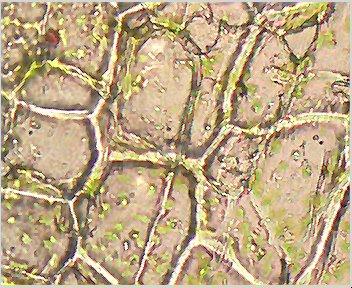 What lab specimen are these cells from? Locate the cell wall, plastids, and possibly stomata. | back 16 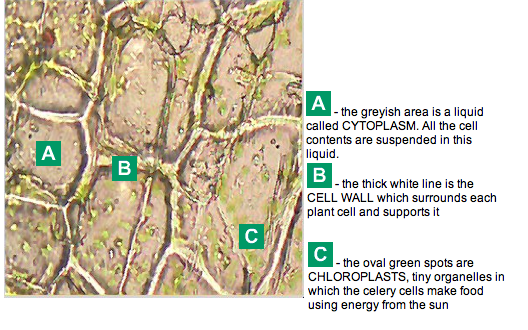 A Celery Stalk |
front 17 What type of plastid would most likely be found in tomato tissue? | back 17 Chromoplasts |
front 18 What kind of plastids are probably in celery tissue? | back 18 Chloroplasts |
front 19 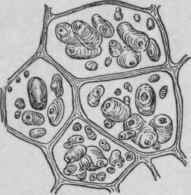 What lab specimen are these cells from? Locate the different structures. | back 19  A potato. |
front 20 What kind of plastids are probably in potato tissue? | back 20 Amyloplastids |
front 21 What are the three characteristics that distinguish plant cells from animal cells? | back 21 1) Chloroplasts
|
front 22 What are the three principal types of plastids and what is the difference between them? | back 22 1) Chloroplast: forms in green plants
|
front 23 What is the purpose of the plasmodesmata? | back 23 To connect the protoplasts of adjacent living cells. |
front 24 Define a eukaryotic cell and give two examples of eukaryotic organisms. | back 24 DEF: A cell that has a membrane-bound nucleus, organelles, and chromosomes in which DNA is associated with proteins.
|
front 25 Define a prokaryotic cell and give an example of a prokaryotic organism. | back 25 DEF: A cell lacking a membrane-bound nucleus and organelles.
|
front 26 What are the four main groups of eukaryotes? | back 26 1) Animals
|
front 27 Briefly describe Cell Theory. | back 27 Cells create organisms. |
front 28 Briefly describe Organismal Theory. | back 28 Organisms create cells. |
front 29 T or F: Plants are eukaryotes. | back 29 True |
front 30 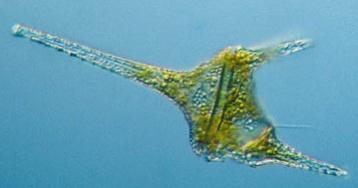 What kind of species of algae is this? | back 30 Dinophyta (dinoflagellates) |
front 31 Why are dinoflagellates interesting biochemically? | back 31 - Their flagella beat within two grooves.
|
front 32 What kind of reproduction do dinoflagellates have? | back 32 Longitudinal Cell Division |
front 33 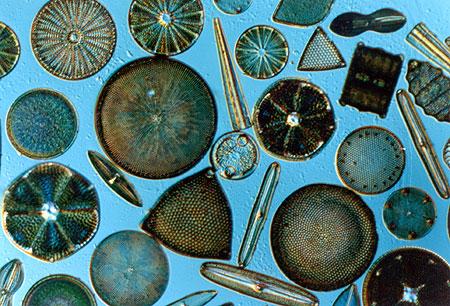 What kind of species is this? | back 33 Bacillariophyta (diatoms) |
front 34 What substance makes up diatom walls? | back 34 Polymerized, opaline silica. |
front 35 What kind of reproduction do diatoms have? | back 35 Asexual by cell division. |
front 36 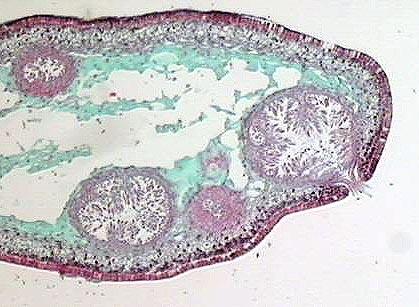 What kind of species is this, what is the name of the hollow chambers and what do they do? | back 36 Species: Phaeophyta (brown algae)
|
front 37 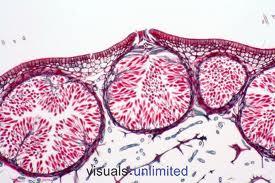 What gender is this Phaeophyta conceptacle and what does it produce? | back 37 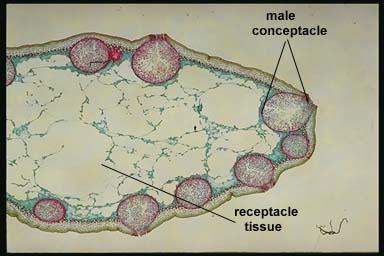 Male Conceptacle.
|
front 38 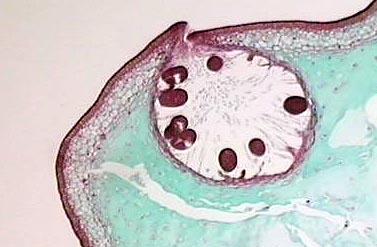 What gender is this Phaeophyta conceptacle and what does it produce? | back 38 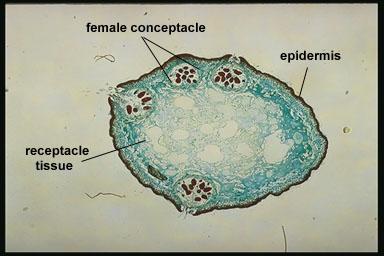 Female Conceptacle.
|
front 39 What kind of reproduction is present in "Fucus" (or Phaeophyta - brown algae)? | back 39 Zygotic Meiosis |
front 40 Why are brown algae (usually) brown? | back 40 They contain xanthophyll fucoxanthin. |
front 41 What is going to happen to the cells within oogonia and antheridia? | back 41 Antheridia produces sperm, Oogonia produces eggs through mitosis.
|
front 42 What kind of reproduction does Rhodophyta (red algae) undergo? | back 42 Sporic Meiosis |
front 43 What is unique about Rhodophyta (red algae)? | back 43 Energy is stored as Floridean starch in the cytoplasm. |
front 44 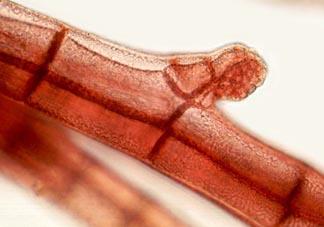 What kind of algal species is this and what are the clumped and individual structures? | back 44 Rhodophyta (red algae)
|
front 45 Why are red algae red? | back 45 They contain phycobilins. |
front 46 Where do red algae tend to occur and what about their coloration is an adaptation to their habitat? | back 46 Red algae occur in deeper water, and their coloration is well suited to this habitat because it absorbs green and blue-green light that penetrates at that depth. |
front 47 What is the second largest group of algae? | back 47 Chlorophyta (green algae) |
front 48 What kind of grouping is Chlorophyta (green algae)? | back 48 Paraphyletic |
front 49 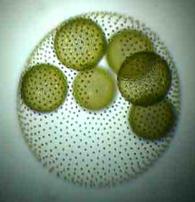 What is the name of this specimen and what type of algae is it? What ploidy level? | back 49 Volvox aureus
|
front 50 Is Volvox unicellular or colonial? | back 50 Colonial |
front 51 Is Volvox motile or non-motile? | back 51 Motile |
front 52 What are the smaller spheres inside the larger spheres in Volvox and how do they emerge from the larger sphere? | back 52 Juvenile spheroids that hatch from the larger sphere activated by heat or hormones depending upon if they're male or female. |
front 53 What plant class are stoneworts a part of? | back 53 Class Charophyceae (charaphytes) |
front 54 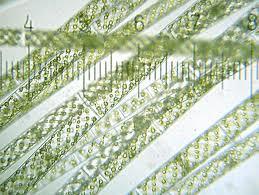 What specimen is this and what type of algae is it? Also label the cell walls and chloroplasts. What is the ploidy level? | back 54 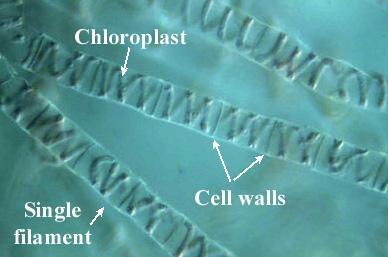 Spirogyra
|
front 55 What are the spiral-like structures in Spirogyra? | back 55 Chloroplasts |
front 56 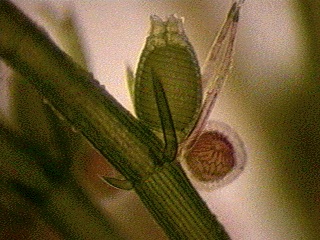 What specimen is this and what type of algae is it? Label the antheridium and ooganium. | back 56 Chara
|
front 57 What kind of reproduction is present in Chara? | back 57 Oogamous |
front 58 What cells are released by antheridia, and by what kind of cell division (mitosis or meiosis) are they produced? | back 58 Sperm by mitosis. |
front 59 What kinds of cells are produced by oogonia, and by what kind of cell division are they produced? | back 59 Eggs by mitosis. |
front 60 What will happen in the oogonia after fertilization? | back 60 It becomes a zygote by meiosis and than goes through mitosis. |
front 61 What are the two different kinds of reproductive means of fertilization? | back 61 Zygotic and Sporic Meiosis |
front 62 What is another name for Sporic Meiosis? | back 62 Alternation of Generations |
front 63 What phyla is called brown algae? | back 63 Phaeophyta |
front 64 What indicates all the descendants of a common ancestor? | back 64 Monophyletic Group |
front 65 Meiosis in which the dominant phase is haploid (some algae and fungi). | back 65 Zygotic |
front 66 Meiosis also known as "alternation of generations". | back 66 Sporic Meiosis |
front 67 fThe root of a phylogenetic tree represents a ____________ . | back 67 Common Ancestor |
front 68 The first photosynthetic organisms that were also called "blue-green algae". | back 68 Cyanobacteria |
front 69 This phyla is also called red algae. | back 69 Rhodophyta |
front 70 Cells engulfed by heterotrophic eukaryotes but, rather than being digested, became symbiotes living within the cell. | back 70 Endosymbiosis |
front 71 The photosynthetic pigment that is responsible for the red color in red algae. | back 71 Phycobilins |
front 72 The photosynthetic pigment that is responsible for the brown color in brown algae. | back 72 Fucocanthin |
front 73 Name the three phyla of non-vascular land plants. | back 73 1) Hepatophyta (liverworts)
|
front 74 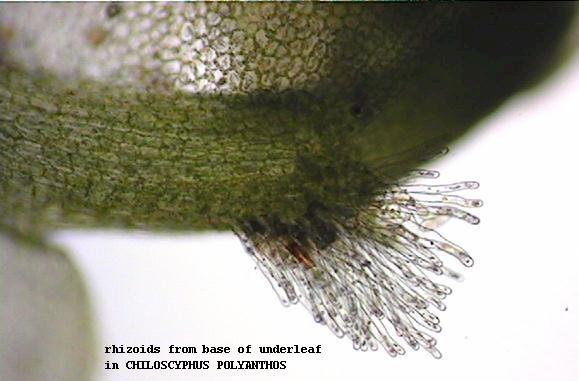 What is the main function of rhizoids? | back 74 To anchor the plants. |
front 75 What is the difference between sporopollenin and cuticle? | back 75 Sporopollenin keeps plant spores from drying out while the cuticle accomplishes the same task for the adult plant. |
front 76 What is another term for sporangium? | back 76 "Capsule" |
front 77 What is the purpose of the sporangium? | back 77 To produce spores. |
front 78 Why do we use quotation marks when referring to "leaf" and "stem" in mosses? | back 78 Both of these structures are haploid rather than diploid as in true leaves and stems. |
front 79 How do the pores on liverwort gametophytes and the stomata on the sporophytes of hornworts, mosses and vascular plants differ? What is their function? What are they? | back 79 Sporophytes - spore producing (diploid phase)
|
front 80 List and explain the innovations that occurred in Bryophytes that distinguish them from the Charophytes. | back 80 1) the presence of male and female gametangia
|
front 81 What major innovations do the green algae have that connects them to land plants? | back 81 - Cellulose
|
front 82 Plants are also known as embryophytes. What does this term mean? | back 82 Means "plants"
|
front 83 What is the function of gemmae cups in Hepatophyta (liverworts)? | back 83 Where the gemmae is produced. |
front 84 What kind of reproduction (sexual or asexual) are gemmae involved in? | back 84 Asexual reproduction. |
front 85 Why are gemmae found in little cup structures? | back 85 So that they may be dispersed by rainfall. |
front 86 What is the difference between a thallus liverwort and a "leafy" liverwort? | back 86 Thallus liverworts: no leaf structures and are flat
|
front 87 Where does the antheridial head of a liverwort arise from? | back 87 Thallus of the gametophyte. |
front 88 What is the ploidy level of the antheridial head of a liverwort? | back 88 Haploid (1n) |
front 89 Once it has reached the archegoniophore in a liverwort, how does the sperm reach the egg? | back 89 Through raindrops splashing sperm onto the egg. |
front 90 What is the ploidy level of the archegoniophore in a liverwort? | back 90 Haploid (1n) |
front 91 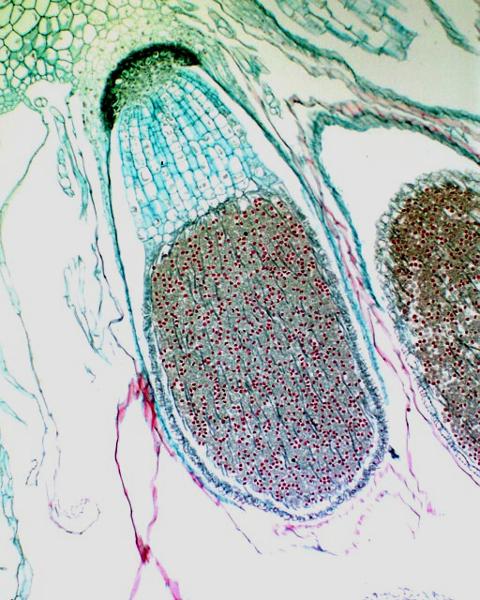 Label the spores, foot, seta, calyptra and sporangium in this liverwort sporophyte. | back 91 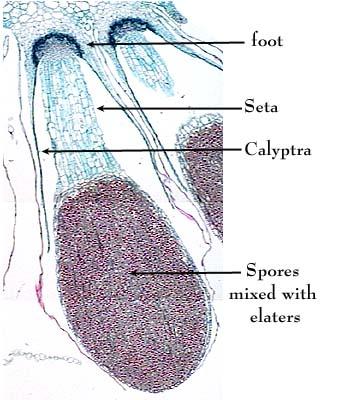 |
front 92 What is the ploidy level of a liverwort sporophyte? | back 92 Diploid (2n) |
front 93 How do the spores leave the sporophyte in a liverwort? | back 93 The sporophyte matures and releases the spores. |
front 94 What happens to liverwort spores once they leave the sporophyte? What will they become? | back 94 The spores germinate and become male or female gametophytes. |
front 95 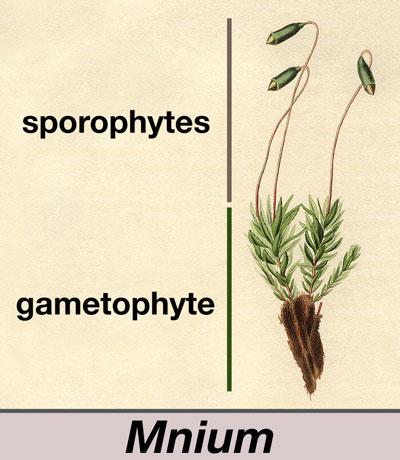 What is this a picture of? | back 95 Bryophyte (mosses) |
front 96 What are the ploidy levels of these Bryophyte structures: gametophyte, sporophyte, seta, sporangium, calyptra. | back 96 Gametophyte (1n), Sporophyte (2n), Seta (1n), Sporangium (2n), Calyptra (2n) |
front 97 Where would you find a stomata? | back 97 On the gametophytes. |
front 98 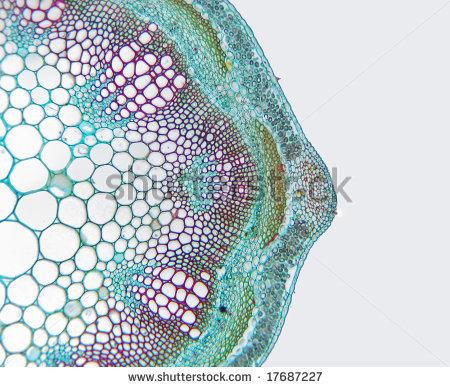 On this Medicago root, label the epidermis, xylem, phloem, cortex and pith. | back 98 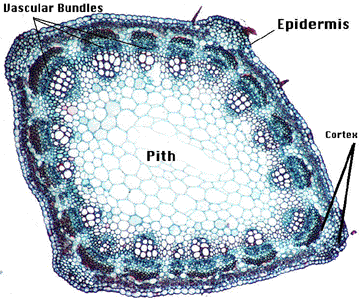 |
front 99 What kinds of meristemic tissue (procambium, protoderm, or ground meristem) do the vascular bundles, epidermis, and cortex come from? | back 99 - Procambium: Vascular Bundles
|
front 100 What is the function of the xylem? | back 100 Conducts most of the water and minerals. |
front 101 What is the function of the phloem? | back 101 Conducts food. |
front 102 Label the upper epidermis, lower epidermis, xylem and phloem of the Medicago Leaf. | back 102 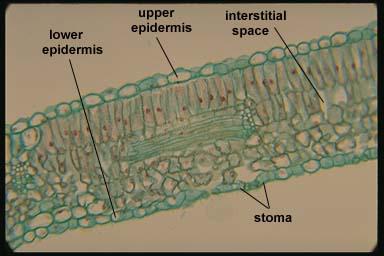 |